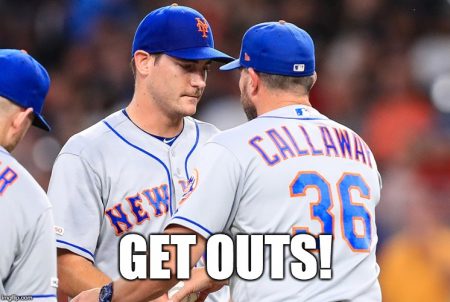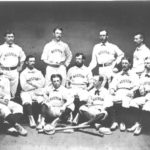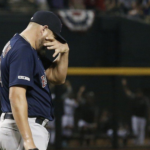How Hard Can It Be to Get 27 Outs?
 Master of Outs
Master of Outs
A Master of Outs wanted immediately. Age and race unimportant. Part-time role. Work three hours once every five days. Or we could ask you to work 10 or 15 minutes, two or three times a week. Depends on your repertoire of skills. In either event you should be a magician with stamina, grit, and determination who can cast spells on hitters working off ten-inch high sloped mounds.
Someone who can throw a horsehide covered ball and dazzle with movement, location, and velocity. Should understand the strategic art of spin rates and subterfuge as well as the value of 27 outs, though that number can be negotiable.
Must be able to maintain composure and effectiveness in the face of pressure situations. Can you bring these qualities to a team? Is this you? Come, help us make the playoffs this year.
The Manager’s View of ‘Outs’
Every manager wants pitchers who take the mound with attitude and a weaponized pitch that gives them a decided advantage.
This kind of edge removes some of the pressure a manager may experience when he puts on his thinking cap. It’s not which pitcher a manager wants to choose from the seven guys in the bullpen, but is Goose Gossage or Bruce Suter or Mariano Rivera ready?
With choices like these, any manager will feel relaxed about the choice he’s about to pencil into the game.
Of course if a manager is bringing in Robert Gsellman or Luke Jackson or Matt Barnes, he may already feel the sweat dripping off his brow. He may already be worrying who he will have to call on next.
That’s when a manager may begin pacing the dugout. Or chew on seeds that can taste as putrid as a ninth inning walk-off loss. Or maybe the manager chews bubblegum? Likes to blow bubbles to let off steam as his pitcher throws pitch after pitch without even recording an out as runners cross home plate gleefully.
No wonder managers cast tortuous glares out at the mound. No wonder managers suffer as they mentally juggle the chance whether their starting pitcher will toss five or six quality innings. Or whether they’ll need a relief pitcher in the second inning to find six or nine or, if the pitcher is effective, twelve outs to calm the burn raging in the managers’ stomach.
That’s why outs are in such great demand. Getting them or not at the right time can change a game, and even a season. Ask Ralph Branca, Mitch Williams or Mark Wohlers about Bobby Thomson, Joe Carter and Jim Leyritz, respectively. Ask them what happened to their hopes for a championship, all because they could not get that key out.
Hope
Hope. A manager hopes his team is not out of the game in the second inning. Or a manager hopes his pitcher will figure out how to get those 18 outs in tonight’s game so he can smile again. Order has been restored, he hopes.
But hope does not record outs. Hope comes in all shapes and sizes, but an out is an out. And sometimes outs are incredibly difficult to come by. There may be lots of tactical choices to get that third out of an inning, or the final three outs of a game. But once the decision is made, all the manager can do is sigh, breathe deeply, and hope his pitcher is up to the task.
The New York Mets and Mickey Calloway
In the middle game of their recently completed three game series with the Atlanta Braves (a series the Mets lost two games to one), the Mets took a 2-1 lead after the top of the seventh inning because their starter Steven Matz was dominant. Matz kept them in the game down 0-1. Once they took the lead in the top of the seventh, all the Mets needed were only nine more outs to win.
The Mets’ manager Mickey Calloway must have begun thinking about those last nine outs once they took the lead.
But how to get those outs?
Matz had retired the last 14 batters he faced prior to the seventh inning. Logic dictated that since Calloway had allowed Matz to bat in the top of the seventh (he scored one of the two runs), Matz would come out to pitch the bottom of the seventh.
Wrong.
The Mets manager decided to go to the bullpen and called upon Seth Lugo, one of the Mets more effective relief pitchers this season. The bottom of the seventh began with Matz a spectator in the dugout.
Because the Mets’ stable of relief pitchers have pitched poorly most of the season, especially Edwin Diaz, the high profile relief pitcher they acquired prior to the season from Seattle, going to the bullpen has cost them game after game. In fact the Mets are third in MLB in most blown saves. (A modern fable. Had the Mets executed every one of those blown saves they could be 85 – 37. In first place. Fantastic? Yes. But. . . )
Ron Darling, the Mets color analyst on the SNY broadcast agreed with Calloway’s decision. Darling admitted this is today’s game–get five or six good innings from the starter and then go to the bullpen. And hope it works out.
But it did not.
The Sad Truth. . .
. . . was that rather than allow Matz to win or lose the game himself (an opportunity he clearly deserved), Calloway chose to play for the win when the team might have had a better chance to win with Matz continuing on rather than bringing in Lugo.
So, Matz, who had thrown only 79 pitches in six effective innings, took a seat and watched the Mets implode.
Seth Lugo threw 26 pitches in his ⅓ of an inning, allowing five runs on five hits. Within a few minutes the game was all but over. The Mets were behind 6-2.
The Mets would lose the game 6-4. The tying runs were on base in the top of the ninth when the ex-Met Jerry Blevins struck out the disappointing Michael Conforto – who never seems to produce in the clutch.
Eyes Open Wide, Shut
The Mets may have gone 19-6 (a .685 winning record) against losing teams after the All-Star break. But Atlanta is not a losing team.
The Mets won the last game of the Atlanta series to prevent a sweep. The win left them with a 3-3 (.500) record against the two teams they’ve faced with winning records so far. Add in last night’s 4-1 loss to Kansas City and they’re 3-4 since the 19- 6 run.
Their failed season – the Mets are now 62 – 60, nine games out of first place, and two games behind for the second Wild Card – continues. It’s only going to get worse as the winning teams awaiting them will exploit their many weaknesses.
Maybe it’s time to admit that the Mets are who they were before their recent 25 game romp. That was, at 40-50, one of the worst teams in baseball.
Nothing has changed. Except a few more wins. Joe Panik is not going to make them a better team. He’s not going to help them record all those key outs they’ll need to make the postseason.
Getting their most important piece back, Yoenis Cespedes, who has been missing in action (collecting $20+ million a season) since July 2018, would be an important positive, but who knows if and when that will ever happen?
There’s chatter now that the Mets may finally see 35-year-old Jed Lowry on a baseball field again. Soon. He’s already missed the first 122 games of this season (like his ex-Boston teammate Jacoby Ellsbury who has not played since the 2017 season). Not even in retrospect, the two-year contract the Mets signed Lowry to was a costly mistake that keeps taking money out of their pockets that could be better allocated elsewhere.
Mistakes like this are further proof of how expertly the Mets are mismanaged. Management still falsely believes (hopes) they can make the post postseason (as they did in 2015 when they can out of nowhere after the Yoenis Cespedes trade). So, management insists on holding onto their most saleable assets because they believe 2015 can come around every year, regardless of their lack of talent. Once again, the Mets are finding out that 2015 will never be an every year occurrence.
That’s why the Mets can be counted on to crash and burn before their annual mesmerizing stretch when they tantalize, only to bitterly haunt their fans once again as they self-destruct down the stretch.

























